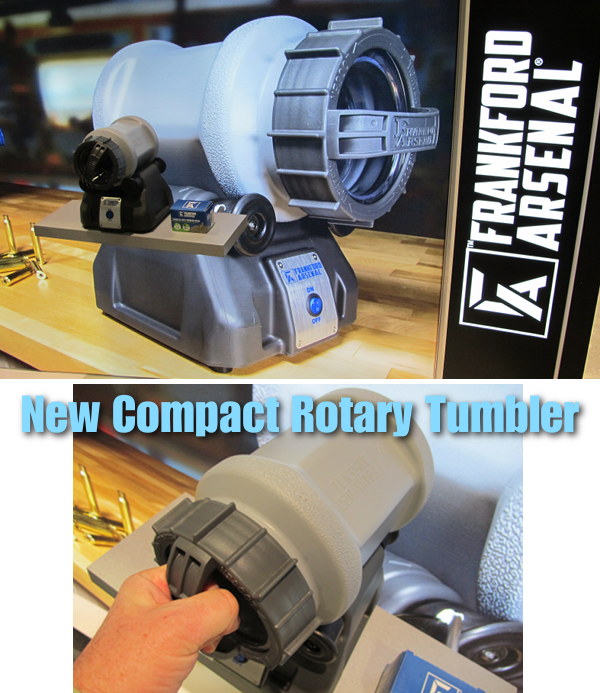SHOT Show 2019 — Eye-Catching Products

There are tens of thousands of products on display at SHOT Show, the world’s largest firearms industry trade show. We visited dozens of manufacturers to see their featured items on display. Here are our selections of interesting products as well as some eye-catching product displays. Check out the cutaway Redding dies, the Norma giant plexiglass bullet shell.
Volquartsen .22 LR Ultralite with ModShot Carbon Stock, 3.8 LBS

Volquartsen showcased a radical rimfire rifle with “carbon everything”. Designed for rapid-fire Steel Challenge games, this unique rig has a carbon-wrapped barrel, carbon buttstock shaft with an aluminum buttplate, and a carbon fiber handhold forward of the action. The ModShot stock secures the bottom of the action, provides attachment points for rear section and front handhold. Total weight (without optics) is just 3 pounds, 13 ounces! MSRP is $1733.00. Our hunting editor, Colton Reid, said this “bare bones” carbon-enhanced design could be adapted for an ultralight centerfire hunting rifle under 5 pounds.
Redding Cutaway FL and Neck Sizing Dies

At the Redding booth, we saw interesting sets of “cutaway” sizing dies. It was cool to see the insides of various types of dies. In the photo above the top two dies are micrometer-top dies. Below are three sizing dies: neck-sizing bushing die at left, a “plain” full-length sizing die in the middle, and a bushing full-length sizing die on the right. The bushing FL die would be our first pick — it allows you to size the entire body of the case, while adjusting neck tension (and bullet “grip”) with the neck bushings.
F-Open Champion with Kestros ZR Stock

Today, January 24th, Norm Harrold, the current F-Open 2018 national champion and 1000 yard record holder, appears at the McMillan booth. In the video above he’s holding the advanced, long-wheelbase Kestros ZR stock he used to set the new National Record and capture his F-Open title. Norm will explain the features of this stock that make it shoot so well. The Kestros ZR’s low COG and long wheelbase help the stock track and resist torque.
Christensen Arms Modern Precision Rifle

Our buddy Jason Baney was mighty impressed with the Modern Precision Rifle from Christensen Arms. With a handsome desert bronze finish, this rifle features carbon-wrapped lightweight barrel, carbon handguard/forearm, and carbon cheek piece. The folding buttstock folds quickly and secures with a magnetic lock. The rifle comes with a sub-MOA accuracy guarantee, and is available in 8 chamberings: .223 Rem, 6.5 Creedmoor, 6.5 PRC, .308 Win, 300 PRC, .300 Win Mag, .300 Norma Mag, and .338 Lapua Mag. Jason was so impressed with this $2295 rifle he said: “this could be my next hunting field rifle”. He said the folding stock really is an advantage when trekking long distances.
Rimfire Cases — How They Are Formed

At the Capstone Precision Group booth, we saw a long sheet of shiny brass metal. We were fascinated. This sheet illustrated how SK .22 LR casings are created from brass, started with a dime-sized flat circle, then ending with an extend narrow cylinder. This then becomes the case which receives the priming material (in the rim), powder and bullet. This is not identical to the actual factory production process, but it does show the key stages of rimfire case “punching” and drawing.
Frankford Arsenal New Compact Rotary Tumbler

Rotary tumblers do a fine job cleaning brass with media in liquid solution. There are many large rotary tumblers on the market. But frankly most are bigger than needed by rifle shooters who might just clean 100-200 pieces of brass at a time. Frankford Arsenal developed a smaller tumbler that runs smaller batches efficiently. Good idea. Look for this product at MidwayUSA in a few months. It should be significantly cheaper than Frankford Arsenal’s large, 7-liter Platinum tumbler which sells for $165.00 on Amazon.
Norma’s Giant See-Through Cartridge Display

Norma, maker of excellent brass, bullets, and loaded ammunition, had a eye-catching prop for displaying Norma bullets and cartridge brass. Over four feet long, this one-of-a-king plexiglass cartridge half-model held hundreds of projectiles and casings. Eye-catching for sure.
AMP Mark II — Runs Longer, Cooler, And Does .50 BMG

The makers of the Annealing Made Perfect (AMP) electro-induction annealing machine showcased a new, upgraded Mark II model. The new Mark II machine looks similar on the outside, but has a number of enhancements. It has bigger strong fans so it ran process more cases before you need to take a break to let the machine cool down. In addition, the Mark II now has a “super-sized” case chamber that can hold virtually any size case — all the way up to the .50 BMG. We watched as the AMP 2 annealed a jumbo .50 BMG in just a few seconds. Very impressive. For more info and pricing, visit www.AMPannealing.com.
Parting Shot — Goblin Green Race Pistol

Eley, the UK-based rimfire ammo maker, had a couple wild-looking race guns on display. This Metallic green stunner features a massive compensator, relieved slide (for faster cycling), and a color-coordinated C-MORE Reflex sight on top. Inconspicuous, this pistol is not!













 Implications for Gun Builders and Reloaders
Implications for Gun Builders and Reloaders




